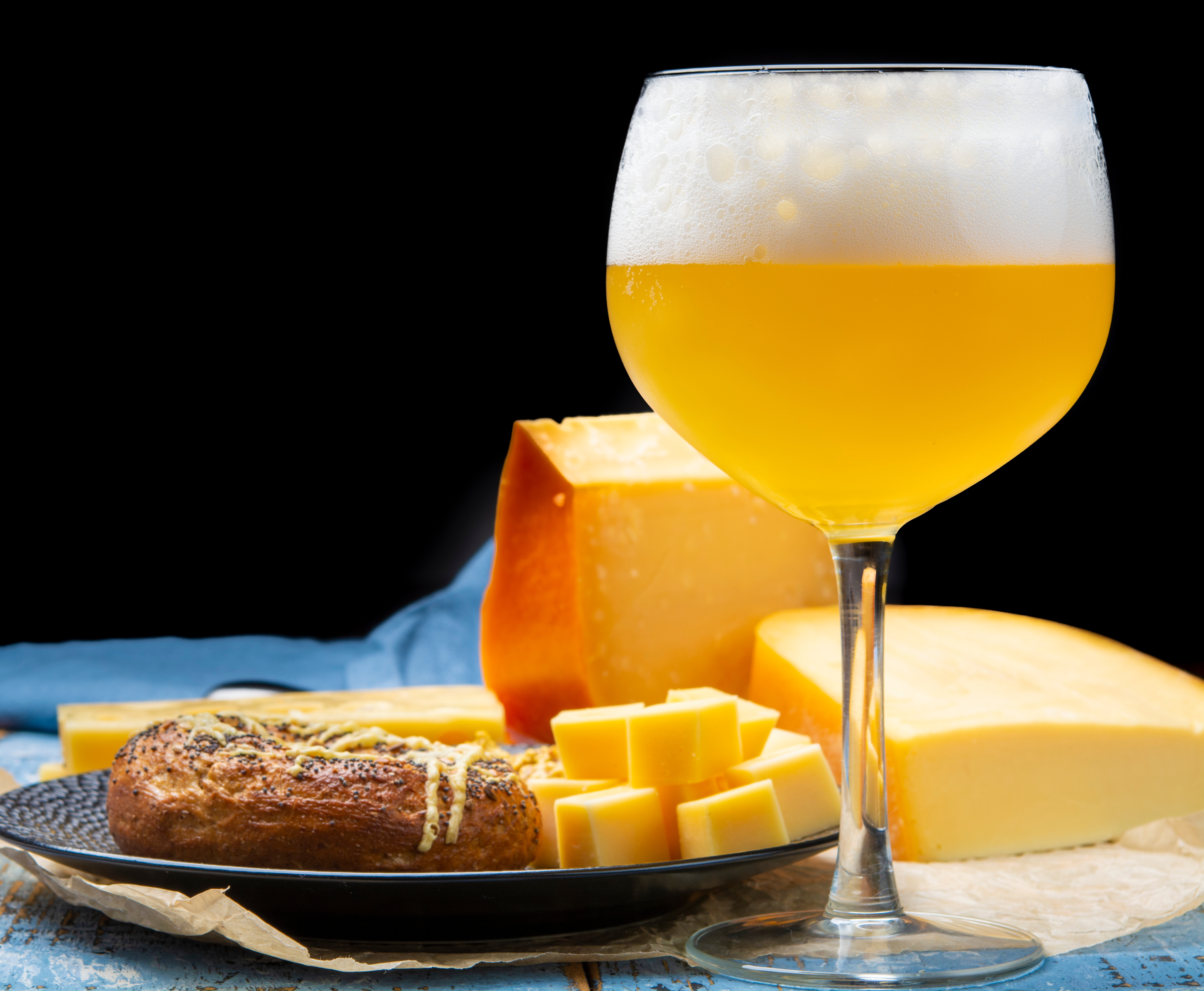
When one hears the term cheese pairings, wine is the beverage that most often comes to mind, we’d wager. Because, of course, it is. The pairing of wine and cheese is as classic a coupling as peanut butter and jelly, bacon and eggs, or chocolate and strawberries. They’re meant to be together. But that certainly doesn’t mean that wine is the only adult beverage that can dance an alluring tango alongside everyone’s favorite dairy product. Beer, as humble as its reputation can be, is also a beautiful balance to cheese’s immense offering of flavors. While some may think of beer as not being as multi-dimensional and varied in its palate-pleasing capabilities as wine, this is not the case – especially now that we live in a world with so many exquisite craft beers, stouts, and lagers.
Of course, another classic accompaniment to cheese is bread or crackers. Why might that be, one might ask. Is it because we’re simply in need of a starchy vessel to usher the cheese into our mouths? The answer is actually a bit deeper than that. Starches like bread and crackers are made from the same yeasty ingredients as beer, so their pairing makes perfect culinary sense.
This isn’t to say, though, that one can simply pick up a hunk of cheddar and crack open a Budweiser and expect culinary artistry. The science is a bit more nuanced than that, so we’re here to help you find the best pairings for your favorite beers and cheeses.
How to pair beer and cheese

When pairing beer and cheese, there are three tasting components to consider when finding a great match.
Complement
Complimentary flavors are sought throughout the culinary world, and beer and cheese are no exception. Just as you wouldn’t pair two mismatched ingredients together in a dish you’re cooking, you wouldn’t want to pair conflicting flavors in your beer and cheese selection. Always consider flavors and how they might balance each other.
Contrast
While this rule may seem contradictory to the first rule of complimenting flavors, they actually work together. Consider everyone’s favorite culinary contrast – sweet and salty. Flavors like peanut butter and jelly work together because they contrast each other so perfectly while also complimenting and playing off each other’s strengths.
Cut
This tasting rule is often mentioned with wine pairings but applies to beer as well. In the same way, you want to balance flavors, it’s important to consider richness and mouth-feel when pairing beer and cheese. A particularly rich and creamy cheese, heavy in both fat and flavor, would pair much better with a light and crisp beer with the strength to cut through some of that richness. A heavily creamy stout wouldn’t provide the same level of contrast and might overwhelm the palate rather than cutting through and contrasting the texture of the cheese.

Our favorite cheese and beer pairings
Cheddar
This classic cheese can be mild, sharp, and extra sharp, depending on your recipe and preferences. We love all of cheddar’s versions in their earthy, nutty, pleasantly bitter, creamy glory.
We love to pair a perfectly aged cheddar with crisp Belgian or Scottish ales or British porters.
Pepper Jack
As its name implies, Pepper Jack cheese is accented with spicy chilis and peppers, giving it its signature kick.
Pairing spice with beer can be tricky, but we love the contrast of Pepper Jack with a rich, intense imperial stout. Crisp laggers and hoppy IPAs are also delicious, along with a bite of Pepper Jack.
Parmesan
Arguably the most famous finishing cheese, parmesan is nutty, savory, sharp, and wonderfully gritty, and it pairs well with just about everything.
We love to pair parmesan with light and refreshing wheat beers or – if you prefer a bit more depth – a medium-bodied, smooth, caramel-y amber ale.
Feta
Tangy, crumbly, briny feta works beautifully both in a vast array of dishes and on its own.
While already delicious in its own right, pair feta with a Belgian-style witbier or a Belgian-style blonde for a gorgeously intriguing pairing.
Goat
Is there anything more delicious than a generous slathering of wonderfully rich and creamy goat cheese atop a slice of crispy baguette? This heavenly cheese is earthy yet tart, sweet yet briny and rich, and we cannot get enough.
If you want to experience true goat cheese perfection, pair it with a German-style pilsner or hefeweizen. You’re welcome.
Gruyere
This semi-hard cow’s milk cheese is our very favorite Swiss variety. Gruyere’s salty, nutty, earthy flavor warms and comforts any dish in contact with it.
We love Gruyere best when paired with American-style amber ales and Scottish bitters.
Manchego
Manchego is an aged Spanish cheese known for its mild, grassy nuttiness and creamy texture. This versatile cheese is a popular charcuterie board choice because of its ability to pair well with many flavors, so feel free to have fun with this one!
Our very favorite pairing for manchego, though, has to be earthy, rye IPAs. If you’re in the mood for something lighter, though, fruitier lagers or even hard ciders are complementary and fun.
Brie
Buttery, creamy, luscious, and almost sinfully delicious brie is known for its soft, supple texture and mild to fabulously funky flavor. We bake it, we wrap it in pastry, we spread it on everything, this gorgeous cheese.
When it comes to beer pairing, while brie’s flavor is relatively mild, we prefer to stick to a beer that can cut through the cheese’s velvety richness. German-style pilsners, weissbiers, IPAs, or Belgian tripels are all fabulous choices.



